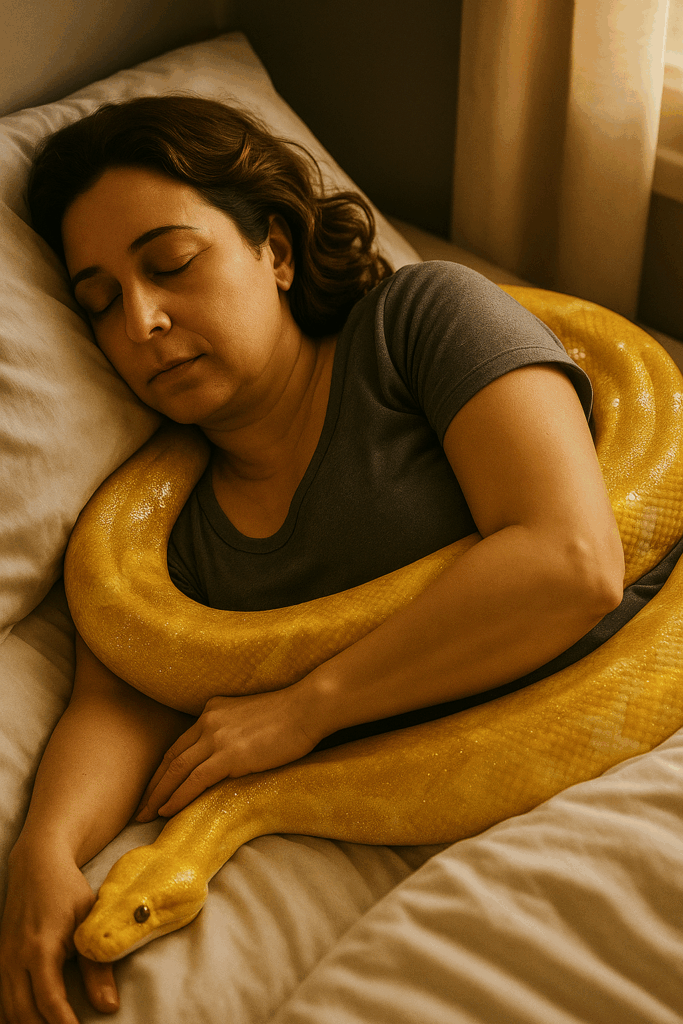The Python I Raised at Home Suddenly Stopped Eating and Wrapped Around My Waist — What I Discovered That Night Changed Everything About My ‘Tame’ Pet 😨
Clara never expected her birthday to bring her the strangest gift of her life. Her older cousin, aware of her fascination with exotic creatures, handed her a small, velvet-wrapped box. Inside, coiled delicately, was a hatchling albino python, no longer than her forearm.
— “She’s yours now. Care for her, and she’ll be loyal,” her cousin whispered.
The snake’s crimson eyes blinked slowly, hypnotic in their intensity. Clara, mesmerized, named her Saffira. Unlike the yellow python from her cousin’s previous stories, Saffira was ghostly, sleek, and mysterious.
At first, Saffira was tiny, easily held in Clara’s palms. She fed her carefully, watched her grow. Soon, the python’s terrarium dominated her living room, a sanctuary of glass and heat lamps.
Family warned Clara.
— “Snakes are unpredictable.”
— “She could crush you one day.”
But Clara, intoxicated by her connection with Saffira, dismissed their worries.
— “She’s different. She’s gentle,” Clara whispered, stroking the snake’s smooth scales.
Saffira’s growth was rapid. Within a year, she became formidable—her body long and heavy, her movements smooth and deliberate. Clara noticed subtle changes.
At first, it was small things: refusing food sometimes, staring at her intently, curling next to her while she slept. Clara laughed nervously.
— “You’re spoiled, aren’t you?”

But nights brought more unsettling behavior. Saffira would slide onto Clara’s bed, resting along her legs, wrapping loosely around her torso. She hissed softly when Clara tried to move her. It felt like an embrace—but deeper, more intentional.
Her eyes followed Clara constantly. She was awake when Clara slept, slithering with unnerving precision.
One stormy night, Clara awoke to a sharp hiss, louder than ever. Saffira had coiled tightly around her waist, chest, and shoulders, weight pressing her to the mattress.
— “Saffira… stop,” Clara whispered, heart pounding.
The snake’s eyes glowed in the dark, unblinking. It wasn’t playful; it was deliberate. Clara realized she couldn’t free herself easily. Panic surged, cold and sudden.
That morning, she scheduled a visit to the vet, though the thought of exposing Saffira to “outsiders” made her stomach churn.
Dr. Lawson, a specialist in exotic reptiles, observed Saffira with a clinical eye. She had seen thousands of snakes, but something about Saffira made her uneasy.
— “She’s acting… unusual,” Clara admitted, voice shaking. “She sleeps with me, wraps herself around me, refuses food… I don’t know if it’s love or…”
Dr. Lawson’s expression darkened.
— “Love doesn’t exist in pythons. What you’re seeing is obsession. She’s exhibiting hunting behavior—only directed at you.”
Clara recoiled.
— “But she’s my companion!”
The vet shook her head gravely.
— “She’s not a companion. She’s a predator. When she refuses food, she’s preparing. The way she coils, presses, and watches you—that’s assessment. She’s calculating whether she could subdue her prey if she chose to.”
Clara’s blood ran cold. Every embrace, every nightly coil, every hiss suddenly made terrifying sense.
Back home, Clara couldn’t sleep. Every creak, every slither in the dark seemed magnified. She found herself watching Saffira constantly, her paranoia growing with each night.
When the snake slithered over her pillow, Clara froze, waiting for the next movement. Her apartment became a cage, and her pet, the warden.
She tried to keep Saffira in her terrarium, but the python’s determination was relentless. At night, she escaped, curling around the bed, inspecting, testing, observing.

Clara’s friends noticed the change.
— “You don’t sleep, you’re pale… what’s happening?”
— “It’s just a snake, Clara,” she said automatically, though inside, she feared it might kill her one day.
One evening, Clara’s phone rang. Distracted, she stepped away from the bedroom, leaving the door ajar. Saffira, sensing vulnerability, slithered quickly and wrapped around Clara’s legs.
— “Saffira! No!” Clara screamed, struggling as the python tightened instinctively.
She barely escaped, slamming the door and barricading herself inside. Bruises formed along her arms and waist.
It was no longer a companion—it was a predator she had allowed too close. The trust she had placed in Saffira was a dangerous illusion.
With a heavy heart, Clara called a wildlife sanctuary specializing in large snakes. Experts arrived, preparing for the delicate operation. Saffira, sensing danger, hissed, lunged, coiled—everything a python should do when defending prey.
Finally, the team sedated Saffira enough to transport her safely. Clara watched as the van drove away, her home suddenly silent, the weight of fear replaced by emptiness.
She realized she had been living with death unrecognized, a predator in disguise, and had been lucky to survive.
Weeks later, Clara returned to her apartment, still shaking at the thought of the python’s strength and calculation. The experience left scars—physical and mental—but also a profound understanding of the danger of underestimating wild instincts.
She posted online:
— “Wild animals are never truly tamed. What we call ‘love’ or ‘trust’ may simply be survival instinct in action. Respect it, or it can kill you.”
Even now, she feels eyes on her sometimes, an echo of the python’s presence in the shadows of her home.
Clara wonders often: Was Saffira ever capable of affection, or had she been a predator all along?
And for anyone reading her story, the deeper question remains:
How often do we mistake instinct for love, or danger for companionship, until it’s too late?


